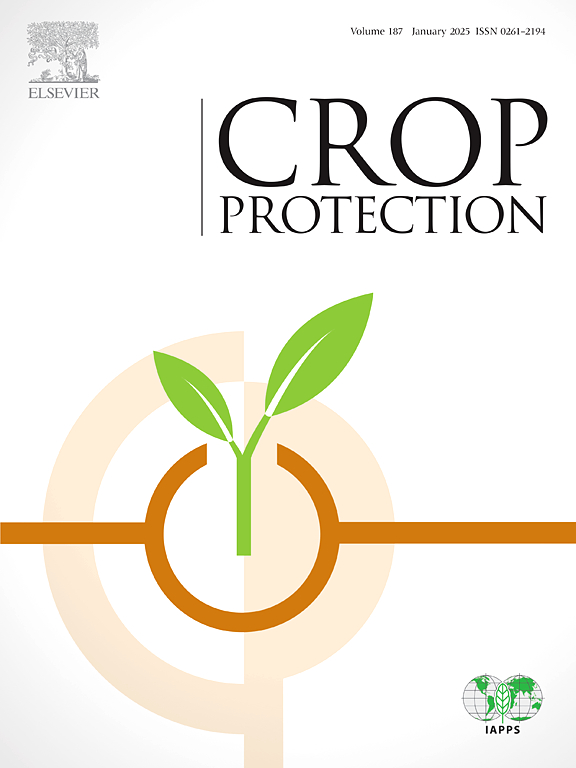Enhancing the shelf life of entomopathogenic nematodes formulation: The impact of super absorbent polymer and infective juveniles concentration
IF 2.5
2区 农林科学
Q1 AGRONOMY
引用次数: 0
Abstract
Entomopathogenic nematodes (EPNs) from the families Heterorhabditidae and Steinernematidae are promising biological control agents against various insect pests. However, one major limitation to their commercial use is their limited shelf life during storage. This study aimed to evaluate the impact of incorporating a super absorbent polymer (A200) into carboxymethyl cellulose (CMC) formulations of infective juveniles (IJs) of提高昆虫病原线虫配方的保质期:高吸水性聚合物和感染性幼体浓度的影响
昆虫病原线虫是一种很有前途的害虫防治生物制剂,属于异虫科和斯坦线虫科。然而,它们商业用途的一个主要限制是它们在储存期间的保质期有限。本研究旨在评估将一种高吸水性聚合物(A200)加入到carpocapsae Steinernema carpocapsae侵染幼鱼(IJs)的羧甲基纤维素(CMC)配方中,每隔两个月对其保质期的影响。本实验采用因子设计,考察不同浓度的高吸水性聚合物(2%和4% v/v)、EPN浓度(4 × 104和8 × 104/mL)和抗菌剂类型(甲醛0.2%或山梨酸0.25%)对cmc配方保质期的综合影响。我们的研究结果表明,抗菌剂的类型显著影响EPN在储存期间的存活率。到第2月末,未经抗菌药物处理的样品存活率急剧下降(≤0.2%)。其中,以含4 × 10³IJ/mL高吸水性聚合物并经甲醛处理的CMC配方中线虫的存活率最高,达到91.50%。此外,我们的数据表明,含有4 × 104 IJ/mL IJ、4%高吸水性聚合物和山梨酸作为抗菌剂的cmc配方在室温下具有较长的保质期。此外,我们发现EPN对库氏赤霉病4龄幼虫的毒力在贮存6个月后没有显著降低。总的来说,本研究强调了配方IJs浓度与非生物因素(如高吸收浓度和抗菌药物)之间复杂的相互作用,这些因素会影响EPN配方的稳定性。它为开发更有效和更持久的基于epn的产品提供了有价值的见解。
本文章由计算机程序翻译,如有差异,请以英文原文为准。
求助全文
约1分钟内获得全文
求助全文
来源期刊

Crop Protection
农林科学-农艺学
CiteScore
6.10
自引率
3.60%
发文量
200
审稿时长
29 days
期刊介绍:
The Editors of Crop Protection especially welcome papers describing an interdisciplinary approach showing how different control strategies can be integrated into practical pest management programs, covering high and low input agricultural systems worldwide. Crop Protection particularly emphasizes the practical aspects of control in the field and for protected crops, and includes work which may lead in the near future to more effective control. The journal does not duplicate the many existing excellent biological science journals, which deal mainly with the more fundamental aspects of plant pathology, applied zoology and weed science. Crop Protection covers all practical aspects of pest, disease and weed control, including the following topics:
-Abiotic damage-
Agronomic control methods-
Assessment of pest and disease damage-
Molecular methods for the detection and assessment of pests and diseases-
Biological control-
Biorational pesticides-
Control of animal pests of world crops-
Control of diseases of crop plants caused by microorganisms-
Control of weeds and integrated management-
Economic considerations-
Effects of plant growth regulators-
Environmental benefits of reduced pesticide use-
Environmental effects of pesticides-
Epidemiology of pests and diseases in relation to control-
GM Crops, and genetic engineering applications-
Importance and control of postharvest crop losses-
Integrated control-
Interrelationships and compatibility among different control strategies-
Invasive species as they relate to implications for crop protection-
Pesticide application methods-
Pest management-
Phytobiomes for pest and disease control-
Resistance management-
Sampling and monitoring schemes for diseases, nematodes, pests and weeds.
 求助内容:
求助内容: 应助结果提醒方式:
应助结果提醒方式:


